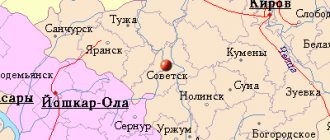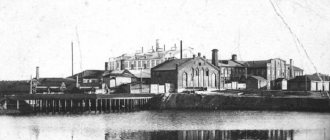Russian city
City in Kaluga region, Russia
| Sukhinichi Sukhinichi | |
| Town[1] | |
| Sukhinichi intersection with coat of arms | |
| Flag Coat of arms | |
| Location of Sukhinichi | |
| Sukhinichi Location of Sukhinichi Show map of Russia Sukhinichi Sukhinichi (Kaluga region) Show map of Kaluga region | |
| Coordinates: 54°06′N 35°21'E / 54.100°N W. 35.350° E. / 54.100; 35.350Coordinates: 54°06′N 35°21'E / 54.100°N W. 35.350° E. / 54.100; 35.350 | |
| A country | Russia |
| Federal subject | Kaluga region[1] |
| Administrative region | Sukhinichi district[1] |
| Based | first half of the 16th century[2] |
| City status from | 1840″[2] |
| Height | 200 m (700 ft) |
| population (2010 Census)[3] | |
| • General | 16,273 |
| • Evaluate (2018)[4] | 14,901 (−8.4%) |
| Administrative status | |
| • Capital from | Sukhinichi district[1] |
| Municipal status | |
| • Municipal district | Sukhinichi municipal district[5] |
| • Urban village | Urban settlement Sukhinichi[5] |
| • Capital from | Sukhinichi municipal district[5], urban-type settlement Sukhinichi[5] |
| Timezone | UTC + 3 (MSK [6]) |
| Postal code(s)[7] | 249270, 249271, 249273–249275 |
| OKTMO I WOULD | 29636101001 |
| Web site | info-sukhinichi.RU |
Sukhinichi
(Russian: Sukhinichi) is a town and the administrative center of Sukhinichi District in Kaluga Oblast, Russia, a major railway junction on the Moscow–Kyiv line, located on the Brin River 105 kilometers (65 mi) southwest of Kaluga, the administrative center of the region. Population: 16,273 (2010 Census);[3]16,387 (2002 Census);[8]17,762 (1989 Census).[9]
Recommendations
Notes
- ^ a b c d f
State Committee of the Russian Federation on Statistics.
Committee of the Russian Federation for Standardization, Metrology and Certification. No. OK 019-95 January 1, 1997 “All-Russian classifier of objects of administrative-territorial division. Code 29 236”, Ed. changes No. 278 / 2015 dated January 1, 2016. (State Committee of the Russian Federation on Statistics. Committee of the Russian Federation on Standardization, Metrology and Certification. No. OK 019-95 January 1, 1997 Russian Classification of Administrative Objects (OKATO). Code 29 236
As amended by Amendment No. 278/2015 dated January 1, 2016). - ^ a b c d
“General information” (in Russian). Retrieved January 5, 2022. - ^ a b
Federal State Statistics Service of Russia (2011).
“All-Russian Population Census 2010. Volume 1" [All-Russian Population Census 2010, vol. 1]. All-Russian Population Census 2010 [All-Russian Population Census 2010]
(in Russian). Federal State Statistics Service. - "26. The size of the permanent population of the Russian Federation by municipalities as of January 1, 2022.” Federal State Statistics Service. Retrieved January 23, 2022.
- ^ a b c d f
Law No. 369-OZ - "On the calculation of time." Official Internet portal of legal information
(in Russian). June 3, 2011. Retrieved January 19, 2022. - Post office. Information and computing center of OASU RPO. ( Post office
).
Search for postal facilities ( Search for postal facilities
) (in Russian) - Federal State Statistics Service of Russia (May 21, 2004). “The population of Russia, the constituent entities of the Russian Federation as part of federal districts, urban settlements, urban settlements, settlements, settlements of 3 thousand or more people.” [Population of Russia, its federal districts, federal subjects, districts, urban settlements, rural settlements - administrative centers, rural settlements with a population of more than 3000 people] (XLS). All-Russian Population Census of 2002 [All-Russian Population Census of 2002]
(in Russian). - “All-Union Population Census of 1989. The current population of union and autonomous republics, autonomous regions and districts, territories, regions, urban settlements and villages. In Sukhinichi, the temple in honor of the Smolensk Icon of the Mother of God is being prepared for the 250th anniversary.” nikatv.ru
. July 21, 2022. Retrieved September 26, 2022. - "Sukhinichi district". Retrieved September 16, 2022.
- "Administration of the urban settlement" City of Sukhinichi "". Retrieved September 26, 2022.
Sources
- Legislative Assembly of the Kaluga Region. Law No. 369-OZ of November 1, 2004 “On establishing the boundaries of municipalities, the territory of administrative-territorial units “Duminichsky district”, “Kirovsky district”, “Medynsky district”, “Peremyshlsky district”, “Sukhinichisky district”, “Tarussky” district", "Yukhnovsky district", and granting them the status of an urban settlement, rural settlement, municipal district", as ed. Law No. 728-OZ of May 29, 2015 “On Amendments to the Law of the Kaluga Region” On establishing the boundaries of municipalities, the territory of the administrative-territorial units “Duminichsky District”, “Kirovsky District”, “Medynsky District”, “Peremyshlsky District” , “Tarussky district”, “Tarussky district”, “Yukhnovsky district”, and giving them the status of an urban settlement, a rural settlement, a municipal district." Came into force after the entry into force of the Law of the Kaluga Region “On changes in settlements on the territory of the administrative-territorial units “Duminichsky District”, “Kirovsky District”, “Medynsky District”, “Peremyshlsky District”, “Sukhinichisky District”, “Tarussky District” ,” Yukhnovsky district of “Kaluga region”, but not earlier than ten days after its official publication. Published: “Vest”, No. 336–338, November 10, 2004 (Legislative Assembly of the Kaluga Region. Law No. 369-OZ of November 1, 2004 On establishing the boundaries of municipalities located on the territory of the administrative-territorial units “Duminichi District” , “Kirovsky district”, “Medynsky district”, “Peremyshlsky district”, “Sukhinichi district”, “Tarussky district”, “Yukhnovsky district”, and on assigning them the status of an urban settlement, rural settlement, municipal district As
amended by the Law dated 29.05. 2015 No. 728-OZ.
On amendments to the Law of the Kaluga Region “On establishing the boundaries of municipalities located on the territory of the administrative-territorial units “Duminichsky District”, “Kirovsky District”, “Medynsky District”, “Peremyshlsky District”, “Sukhinichsky District” "", "Tarussky district", "Yukhnovsky district" and on assigning them the status of an urban settlement, rural settlement, municipal district"
. Comes into force after the Law of the Kaluga Region "On changing the status of settlements located on the territory of administrative-territorial units "Duminichsky district", "Kirovsky district", "Medynsky district", "Peremyshlsky district", Sukhinichi district", "Tarussky district", "Yukhnovsky district" of the Kaluga region", but not earlier than ten days after the official publication.).
Cities
Sukhinichi city
- a city in Russia, the administrative center of the Sukhinichi district of the Kaluga region. A junction of railway lines (to Bryansk, Moscow, Roslavl, Tula), two large railway stations - Sukhinichi-Glavnye and Sukhinichi-Uzlovye. Located in the Kaluga region, on the left bank of the Bryn River, 5 km from the M3 Moscow-Kyiv highway, 105 km southwest of Kaluga. With the construction of the Moscow-Kursk, Moscow-Brest and Syzran-Vyazemskaya railways, Sukhinichi became an important railway junction, a center for trading hemp oil, etc.
OKATO code: 29236501 Founded: 1st half. 18th century City since: 1840 Deviation from Moscow time, hours: 0 Geographic latitude: 54°06′ Geographic longitude: 35°21′ Altitude above sea level, meters: 200
Education in the city of
Sukhinichi
On the territory of the city there are 5 urban schools (Schools No. 1,2,3,4,12) and a large number of rural and village schools: Seredeyskaya secondary school, Shlipovskaya secondary school, Alnerskaya, Dabuzhskaya, Glazovskaya, Khotenskaya. In addition, in the city of Sukhinichi there is a professional lyceum - PL-17 (now the State Educational Institution “College of Transport and Service”), where you can receive secondary vocational education.
Economy of the city of
Sukhinichi
Furniture production Garment industry Plastic products factory Railway transport enterprises There is a drying and dairy plant
History of the city of
Sukhinichi
This city was founded at the end of the 18th century, but was never an administrative center, never had the status of a county town and is one of those very few Russian cities that built themselves, thanks to the development of economic life, and were not built for the military or administrative needs.
Even before it became a city (1840), the village of Sukhinichi served as an important transshipment point for goods such as lard, hemp, hemp oil and others, heading through it to the piers of the Volga and Western Dvina. Trade was one of the characteristic features of this point at that time. In winter alone, from six to ten thousand loaded carts passed through it annually, and the turnover of this trade was no less than 25 million rubles. As a rule, the goods were sent to the Zubtsovskaya and Rzhevskaya piers, and from there to the Riga and St. Petersburg ports.
Active economic development in the region began in the late 18th and early 19th centuries, when the city of Sukhinichi began to acquire important commercial importance. During this period, all the main surviving monuments of architecture and urban planning were built. Famous archaeological monuments date back to the first half of the first millennium of the new era - these are mounds, fortifications, and settlements.
After two railways were built through Sukhinichi (the Moscow-Bryansk branch of the Moscow-Kievo-Voronezh branch and the Dankov-Smolensk branch of the Ryazan-Uralskaya), the city’s prosperity, trade and industry received an additional impetus for development. Thus, being connected with nearby and more distant settlements, this town attracted more and more people to live there, although it did not have county status. Even in the first years after the October Revolution in Sukhinichi, as a rule, there were large bazaars on Saturdays and Sundays, and fairs twice a year, which were popular not only among nearby, but also quite remote settlements.
The means of delivering food and various products were, of course, carts of various designs, and on market days throughout the middle part of the town there were shafts pointing upward from carts bringing various goods for sale.
The events of 1917 made significant adjustments to the development of not only the city of Sukhinichi, but also the entire country. In the 20-30s. changes occurred in all areas of activity, culture and religion of the city residents.
In 1927, the city became the center of the newly formed Sukhinichi district of the Kaluga province.
In 1929, the city became the center of the Sukhinichi district and the Sukhinichi district of the Western region.
In 1930, the Sukhinichi district was abolished, in 1937 - the Western region, the city became part of the Smolensk region.
During the Great Patriotic War it was occupied from October 7, 1941 to January 29, 1942. Every year on January 29th the City Liberation Day is celebrated.
Since 1944, the city has been part of the Kaluga region.
On December 23, 2006, a monument to K.K. Rokossovsky, who commanded the 16th Army that liberated the city, was erected in Sukhinichi.
| Coat of arms of the city of Sukhinichi - Historical coat of arms of the city of Sukhinichi: “The shield is divided into two parts: in the top there is the coat of arms of Kaluga, and in the bottom, in a blue field there is a field of trading scales and under them two barrels.” | The flag of the city of Sukhinichi has not yet been approved and is therefore missing |
Sukhinichi
(Kaluga region)
OKATO code:
29236501
Founded:
1st half.
18th century City since:
1840 City of district subordination (Sukhinichi district, Kaluga region)
Center:
Sukhinichi district
Telephone code (reference phone)
| 48451***** | 22-2-22 |
Deviation from Moscow time, hours:
0
Geographic latitude:
54°06′
Geographic longitude:
35°21′
Altitude above sea level, meters:
200 Sunrise and sunset times of the Sun and Moon in the city of Sukhinichi
Map
| Sukhinichi: maps |
Sukhinichi: photo from space (Google Maps) Sukhinichi: photo from space (Microsoft Virtual Earth)
| Sukhinichi. Nearest cities. Distances in km. on the map (in brackets along roads) + direction. Using the hyperlink in the distance , you can get the route (information courtesy of the AutoTransInfo website) | |||
| 1 | Duminichi | 23 (32) | SW |
| 2 | Meshchovsk | 24 (26) | WITH |
| 3 | Kozelsk | 29 (32) | IN |
| 4 | Sosensky | 40 (47) | IN |
| 5 | Babynino | 41 (45) | NE |
| 6 | Ulyanovo | 44 (80) | YU |
| 7 | Mosalsk | 48 (57) | NW |
| 8 | Przemysl | 55 (69) | IN |
| 9 | Zhizdra | 56 (64) | SW |
| 10 | Baryatino | 58 (95) | NW |
| 11 | Chekalin | 58 (99) | IN |
| 12 | Vorotynsk | 61 (115) | NE |
| 13 | Belev | 61 (69) | SE |
| 14 | Lyudinovo | 64 (90) | SW |
| 15 | Kirov | 68 (120) | Z |
| 16 | Khvastovichi | 72 (106) | YU |
| 17 | Yukhnov | 72 (120) | WITH |
| 18 | Suvorov | 74 (102) | IN |
| 19 | Kaluga | 75 (96) | NE |
| 20 | Tovarkovo | 76 (93) | NE |
| 21 | Bolkhov | 83 (114) | SE |
| 22 | Kondrovo | 86 (104) | NE |
| 23 | Dyatkovo | 86 (124) | SW |
| 24 | Odoev (Tula region) | 89 (112) | IN |
| 25 | Ivot (Bryansk region) | 89 (136) | SW |
| 26 | Lyubohna (Bryansk region) | 91 (134) | SW |
| 27 | Spas-Demensk | 92 (137) | NW |
| 28 | Betliza | 92 (155) | Z |
| 29 | Znamenskoye (Oryol region) | 93 (217) | YU |
| 30 | Fokino | 94 (151) | SW |
a brief description of
The city is located 105 km southwest of Kaluga. Railway junction lines.
Territory (sq. km): 13
Information about the city of Sukhinichi on the Russian Wikipedia site
Historical sketch
Founded as a village in the first half of the 18th century. At the beginning of the 19th century. together with the nearby villages, it formed one large community of sovereign peasants, and was an important warehouse and trading point for goods heading to the piers of the Volga, Western Dvina and beyond. Every winter, from 6 to 10 thousand carts passed through Sukhinichi.
Since 1840, the city of Kaluga province. The name comes from the nickname Sukhin with the patronymic suffix -ichi (for example, in the neighboring Belevsky district, in the 16th century there were landowners Sukhinins).
In 1856, in the provincial town of Sukhinichi, Kozelsky district, Kaluga province, there were 3 churches, 911 houses, 28 shops.
With the construction of the Moscow-Kursk, Moscow-Brest and Syzran-Vyazemskaya railways, Sukhinichi became an important railway junction, a center for trading hemp oil, etc.
During the Great Patriotic War of 1941-45, the city was occupied by Nazi troops on October 7, 1941. It was liberated on January 29, 1942 by troops of the Western Front during the Rzhev-Vyazma operation.
Economy
Factories: automatic lines, radio tube, brick, vegetable concentrates, brewing. Factories: plastic products, clothing. Railway transport enterprises.
Main enterprises
GARMENT INDUSTRY
OJSC "Sukhinichi Garment Factory"
249270, Kaluga region, Sukhinichi district, Sukhinichi, lane.
Pionersky, 6 Offers:
Men's suits, trousers, jackets, skirts, mittens
| Population by year (thousands of inhabitants) | |||||||
| 1856 | 6.7 | 1989 | 17.8 | 2006 | 16.0 | 2015 | 15.4 |
| 1897 | 5.4 | 1992 | 18.3 | 2007 | 15.9 | 2016 | 15.1 |
| 1926 | 6.6 | 1996 | 18.5 | 2008 | 15.8 | 2017 | 15.1 |
| 1931 | 7.1 | 1998 | 18.4 | 2010 | 15.4 | 2018 | 14.9 |
| 1939 | 10.8 | 2000 | 18.3 | 2011 | 16.3 | 2019 | 14.7 |
| 1959 | 12.7 | 2001 | 18.1 | 2012 | 16.0 | 2020 | 14.8 |
| 1970 | 16.5 | 2003 | 16.4 | 2013 | 15.9 | 2021 | 14.6 |
| 1979 | 16.4 | 2005 | 16.2 | 2014 | 15.6 | ||





